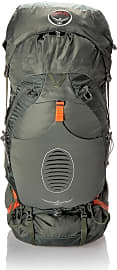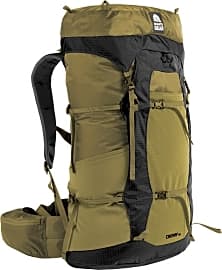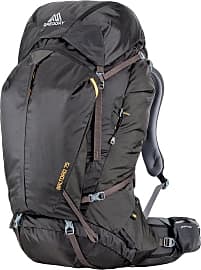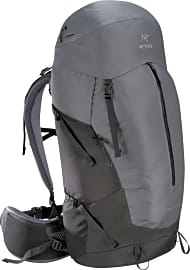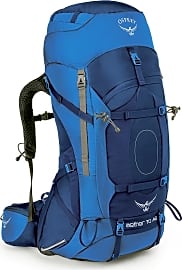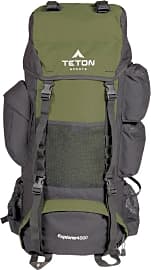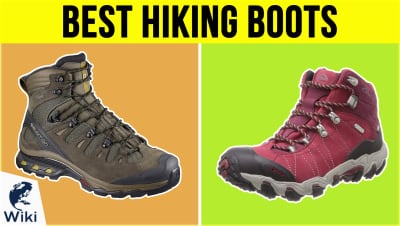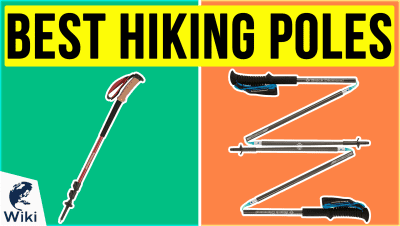The 10 Best Hiking Backpacks

This wiki has been updated 38 times since it was first published in October of 2016. If you're serious about hiking and camping, you know external frame backpacks just don't cut it anymore. To make your next outing truly comfortable and enjoyable, invest instead in one of these internal models, which offer more support and ergonomic features than their old-school counterparts. This list covers options suitable for all budgets and trips, from short overnighters to longer treks. When users buy our independently chosen editorial picks, we may earn commissions to help fund the Wiki.
Editor's Notes
April 08, 2021:
Hiking backpacks are sometimes updated seasonally, but the most popular and refined models can make it years without needing updates. This is a large part of why the Granite Gear Blaze and Granite Gear Crown 2 remain in the top three. On the other hand, some companies just can't resist making small changes and re-releasing classics, which why the slightly updated Osprey Atmos AG also remains in the second spot. The Opsrey and its predecessors are still, to this day, among the most frequently spotted in international airports.
As far as the recent changes made to this Wiki, there haven't been many. We have stopped recommending the AmazonBasics model, largely because the Teton Sports Explorer 4000 performs better and costs about the same. To replace the generic backpack we removed, the Gregory Optic is an interesting newcomer to our list that straddles the line between traditional through-hiking packs and more advanced ultralight options.
January 23, 2020:
There are quite a few backpacks on the market these days, but a surprising amount of them are both heavy and not very comfortable, so it's important to find the right one so your back, knees, and feet stay safe and in good shape throughout your backpacking trip. If you don't plan on using it often, or if you're mostly using it for travel rather than backcountry hiking, the AmazonBasics Backpack and Teton Sports Explorer 4000 are both worth a look. The AmazonBasics is, as its name suggest, pretty basic, but in light of its price, it's hard to beat the value; it just won't stand up to very frequent use. The Teton is a bit more durable, although neither one is likely comfortable enough for hikers who regularly conquer 15 to 20 miles in a day. For just a bit more, you can pick up the Kelty Coyote 80, which has plenty of room inside and is made with the reliability you'd expect from such a popular brand. In that same price range are the Osprey Exos 48 and Granite Gear Crown 2, which are considerably different beasts from most others. They're not ideal for loads over 40 pounds, generally speaking, but they weight very little and are great for minimalist hikers. In fact, I've put down hundreds of miles in a slightly older version of the Exos, and the few issues I've had with it have been largely addressed in the most recent models.
If you're looking for something with a proven pedigree and high-end technology, the Granite Gear Blaze may be your best best. It's surprisingly lightweight for such a solid-feeling and high-capacity pack, and it isn't even terribly expensive. The same can be said for the Osprey Atmos 65, though it's not as light, and the Arc'teryx Bora AR 63, which unfortunately costs quite a bit. And if you plan to go on many long-distance through-hikes in inclement weather, you'd be hard-pressed to do better than either the Osprey Aether 70 or Gregory Baltoro. The Gregory, in particular, holds up well under very heavy loads and has an advanced suspension design that will stay comfortable even after many, many miles in the wilderness.
There are also quite a few specialist models that come from boutique stores, so if you're okay with spending a premium, check out the manufacturers we've outlined in the Special Honors section. We'd also strongly recommend a high-quality pair of boots, set of hiking poles, and of course, a reliable and lightweight backpacking tent.
Special Honors
Gossamer Gear Mariposa 60 Despite a maximum weight of about 2 pounds and a capacity of 60 liters, the Mariposa costs quite a bit less than many other high-end options. Seasoned hikers as well as beginners would do well to pick one of these up; while ultralight options like this one aren't generally the most durable choices, this one in particular should perform very well for at least a couple years. gossamergear.com
Hyperlite Mountain Gear If you're a stickler for a low base weight, HMG has almost certainly got something for you. Their impressively engineered equipment isn't limited to just packs, either; they offer some of the most advanced tents and other accessories with incredibly performance-to-weight ratios. As you might expect, though, such quality costs a lot of money. hyperlitemountaingear.com
ZPacks Backpacks These folks were some of the first to recognize the rising popularity of lightweight and waterproof cuben fiber (now known as Dyneema) as a primary pack material. Their backpacks are remarkably light and spartan, and they also offer a long line of attachments, so you can configure yours to provide exactly the functionality you need. zpacks.com
Internal Versus External Frame Backpacks
The biggest disadvantage to internal frame backpacks is they don't provide as much support or weight distribution as external frame models.
As you may have guessed by the name, external frame backpacks have a clearly visible frame on the outside of the pack. Some may consider external frame backpacks as old school or outdated, but this design offers some distinct benefits. It also happens to have some inherent disadvantages.
External frame backpacks usually have a large number of pockets and segregated compartments. This makes it easier to keep your gear organized and quickly accessible. The external frame also provides you with a place to attach gear externally, like hiking poles and hatchets. Because of the way the pack attaches to the frame, it often sits an inch or two off your back, providing a large ventilation channel, helping you to stay cooler. The rigid external frame helps to promote a more upright posture while walking, as well, which can reduce the chances of back pain after a long hike.
Most of the downsides to external frame backpacks stem from their large size. They tend to be bulky, difficult to maneuver when donning and removing, and can easily knock a person off balance if they lean too far to one side or the other. Due to the way they sit a little bit off the body, they drastically change your center of gravity, which takes some getting used to. They also make it difficult to thread your way through tight trails, as the large frame can get caught up on branches and rock outcroppings.
Internal frame backpacks excel in the very areas where external frame models fail. There is no chance of the frame getting caught on anything, since it is fully integrated within the pack itself. They also sit very close to the back, thereby only minimally altering your center of gravity. The form-fitting design practically hugs the body, essentially becoming one with the hiker. Because of this, there is less chance of losing your balance due to the shifting weight. Their slim shape also makes it easier to safely maneuver through tight areas of the trail.
As with external frame backpacks, internal frame backpacks do have some downsides. They tend to have less external organizational pockets, though this isn't true for all models. The lack of a frame also means there is less space to affix external gear. Many manufacturers combat this by adding MOLLE-style straps. The biggest disadvantage to internal frame backpacks is they don't provide as much support or weight distribution as external frame models.
Front-loading Versus Top-loading Designs
Internal frame backpacks come in both front-loading and top-loading designs. Front-loading designs offer a higher degree of security than top-loading models. This is because you can use a padlock to secure the zippers, effectively preventing access. Top-loading designs usually have a simple drawstring and plastic clasps, making it practically impossible to lock them in any manner. The downside to front-loaders is that having zippers adds a failure-prone mechanical opening device to your pack. For this reason top-loading packs are more durable. Front-loading backpacks are easier to pack and unpack, however, since they essentially open just like a suitcase, giving you physical and visual access to almost the entire interior compartment. This means you can quickly retrieve a specific item, no matter where it is in the pack, without having to remove a bunch of extra gear.
Top-loading packs are often slimmer than their front-loading counterparts. This can make them better for smaller people who may have trouble handling a wide, bulky pack. It is also makes them easier to maneuver though tight spaces. Since top-loading packs are long and thin, as opposed to wide and short, they offer better weight distribution. Instead of the majority of the weight sitting on your mid-back, it will be more evenly distributed between the lower, middle, and upper portions. Most top-loading packs also have a skirt that expands upwards to give you more storage capacity. Front-loading packs are limited to the size of their design, as they won't have any manner of expanding their capacity. Neither style of pack is inherently better than they other. It just comes down to a matter of preference.
What Else To Consider When Choosing An Internal Frame Backpack
Capacity is one of the main factors that you must take into account when picking between the different models. Obviously a backpack that is perfect for a short two-day hike won't be as well-suited to a three-week excursion, as the type and amount of gear you will need to bring along will vary greatly. Hiking packs are measured in either cubic inches or liters. The larger the pack, the more it can carry, but the more cumbersome it will be. It is important to note the weight of a pack greatly affects a hiker's endurance. Your best bet is to make a list of all of the gear you plan on bringing along, or even better, lay it all out in front of you to help you better determine how much capacity you need. If you don't have a specific trip in mind, or don't know exactly what gear you are going to bring along, a 4,000-cubic-inch (65L) pack is a good middle of the road size that works well for both short and long trips.
You should also take into account comfort and fit. Most internal frame backpacks have a good degree of adjustability, allowing you to customize the harness to fit your torso length, but it is still important to keep in mind the size of the user when purchasing a pack. As you might imagine, it can be nearly impossible for a slim, 110lb. woman to navigate a hazardous trail with giant 75-liter pack on her back, whereas a 220lb., 6-foot guy might be able to do so with ease. Thick padding on the back panel, shoulder straps, and waist belt can great enhance the comfort a pack offers when it is fully loaded, so these are smart features to look out for. A breathable mesh backing is also a nice touch.
Other features that can make or break a backpack include the number and size of external pockets, options for attaching external gear, overall durability, and level of water-resistance.


